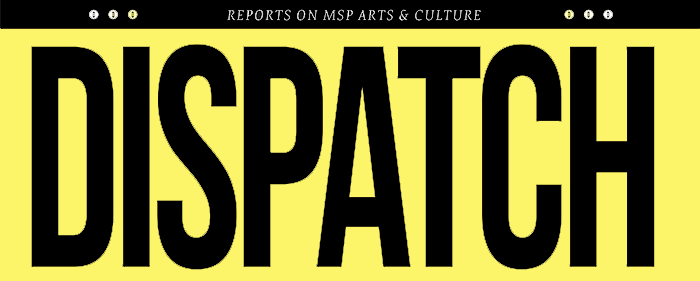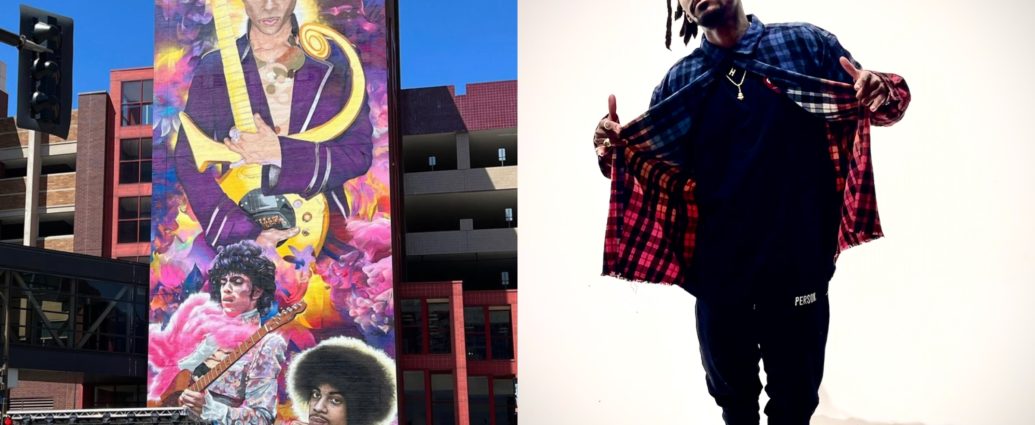Yes, it’s finally time we get a gigantic Prince mural. But this is a town full of critical artists! Does the new tribute pass critical art review?
It is, in some sense, wholly appropriate that Hiero Veiga’s new mural of Prince in downtown Minneapolis is enthroned upon a parking garage in his hometown. The word garage, coming to us via the French garer, to shelter, and ultimately, from the Old French garir, means “to take care of, protect.”
The tripartite image has been erected as a sort of quasi-spiritual protector of the city, a three-in-one trinitarian depiction of the man in three stages of his life. Perhaps there are religious interpretations here – trinitarian depictions of the Father, the Son and the Holy Spirit abound in art, and here indeed the hieratic appearance of the Father, serene and all-knowing, uplifted above the other figures, recalls such depictions, beginning as early as the fourth century – though one is loathe to read too closely into this aspect, contrary as they are to the non-trinitarian beliefs of Prince’s chosen spiritual community, the Jehovah’s Witnesses.
In purely secular terms, it alludes as well to the artistic trope of the “river of life.” In this pictorial cycle, we find Prince as a young man in Minneapolis, beginning his journey in the flush of youth, imbued with that confidence and sense of self-belief in his own fantastical abilities and ambition, his trademark half-smile already fixed into place.
In mid-life, we find him struggling, with the tool of his trade, the guitar, with the vigor and self-sacrifice of a laborer wielding a thresher, his face a mask of passion and desire, the look of youth replaced by that of turmoil, alluding to his struggles against the record company establishment to wield full control over his creative work.
Finally, in the end, we find “the chains of corporeal existence are falling away; and already the mind has glimpses of Immortal Life,” in the words of American painter Thomas Cole. In this final iteration of Prince, wielding his guitar that has been transfigured into the artist’s legendary glyph, itself suggesting the ankh or the Knot of Isis from Ancient Egyptian art, signifying variously the cohesion of heaven and earth, of male and female, and of eternal life, passing from the material plane into the spiritual one. It is this future that hovers above all others, ascendent over the disordered, romantic landscape that envelopes the three figures. It is imbued with purple, yellows and reds, a disjunctive vision of fiery apocalyptic vision that suggests the work of painter John Martin. It is purple, obviously, that is most highlighted, appropriately the color most associated with Prince. Purple, traditionally, represents “creativity, extravagance, dignity, grandeur, independence, pride, peace, mystery, and magic,” as the critic Eva Heller has written.
In Veiga’s abstracted organic masses, one imagines floral motifs, clouds, water and other elemental forces, connecting the story of Prince to that of much larger one that suffuses all narratives across all cultures: the progression of a mortal being from humble, earthly beginnings to transcendent fulfillment across the starry vault of heaven.
Linda Stanley-O’Connor, PhD
Princeton University
Editor’s Note: None of the art critics we spoke with would use their real name to critique a giant Prince mural in Minneapolis, even politely. So the author chose to use a different name and corresponding title.


Comments are closed, but trackbacks and pingbacks are open.